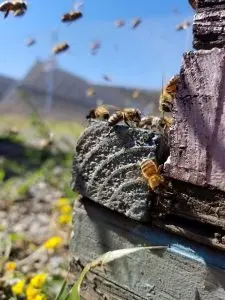At a solar farm surrounded by orchards near Medford, Oregon, native flowers are beginning to bloom between the solar panels, and 48 beehives sit at the edge of the field. The solar farm, called Eagle Point, is now the largest “solar apiary”–a solar energy project designed to benefit pollinators–in the country.
“For me, it comes from a place of wanting to change the culture of solar and really taking into consideration more than just the panels,” says Julianne Wooten, environmental manager for Pine Gate Renewables, the North Carolina-based solar power company that developed the site.

In 2017, the company began working on a new project to keep land productive at its solar farms, reintroducing native plants, and, in some cases, working with farmers or ranchers to plant crops or graze animals around the panels. A nonprofit called Fresh Energy helped connect the company with a local beekeeper who happened to be looking for a new home for some of his hives. (This isn’t the only smart combination of clean energy and agriculture: a solar farm in Japan is growing mushrooms under the panels.)

For the owner of a solar farm, seeding fields with native flowers and grasses has a higher upfront cost than at a typical installation; Pine Gate also worked with experts in restoration to ensure that they were making changes that were ecologically sound. But roughly a third of the maintenance costs of a solar farm can come from managing vegetation. Depending on the location, grass growing under panels might need to be mowed eight times a year. Shifting to natural vegetation can reduce that to one or two times a year, and should save the company money over time.
“It is more expensive on the front end, and I think that’s why it’s hard to gain quick traction within the industry,” says Wooten. “People want to see that it’s going to work out.” The company partnered with the National Renewable Energy Lab to study the project, and the federal lab will install test plots at Eagle Point and at some of the company’s other sites to study the native vegetation and crop performance, ultimately sharing results with other solar developers to improve industry standards.
“One of the goals of the project is to create a database that can be utilized by other developers to show them what native species will thrive in a given area and really further the industry,” she says. One recent study estimated that existing and planned solar plants are near more than 860,000 acres of farmland that could benefit from better access to pollinators. “If this became even remotely the norm, the amount of habitat that these solar farms could provide to these pivotal parts of our economy could be really big, especially as solar continues to grow.”
Recognize your brand’s excellence by applying to this year’s Brands That Matter Awards before the early-rate deadline, May 3.
